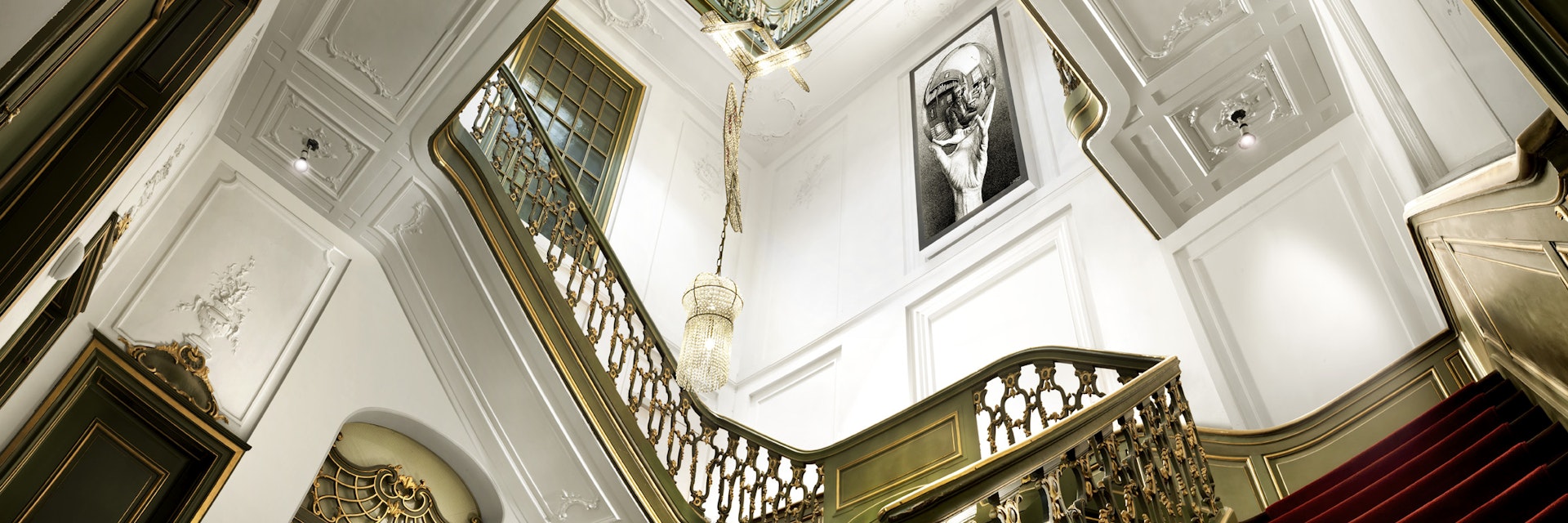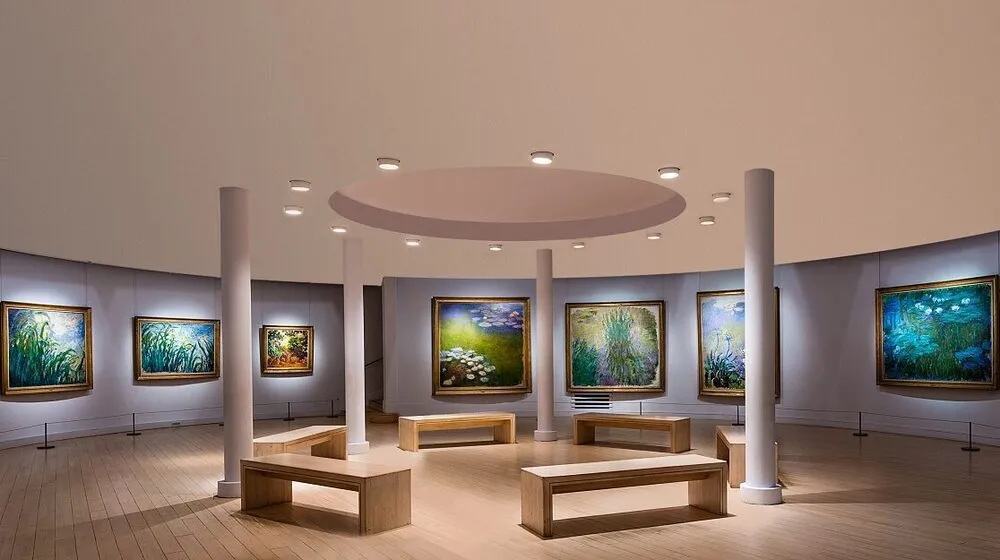
Table of Contents
Introduction: A World Beyond the Mainstream
Art Museums- Tucked away from the towering marble columns of world-famous art institutions lie sanctuaries of visual splendor—intimate, lesser-known art museums that embody the soul of local culture and the spirit of creative rebellion. These are not your typical tourist-laden galleries where velvet ropes guard priceless works behind throngs of selfie sticks. These are hidden havens—places where art breathes in silence, where curation is more passion than prestige, and where stories unfold not just on canvas, but in the very walls that cradle them. Welcome to a world of artistic intrigue—here are the 7 Hidden Gem Art Museums You’ll Love to Discover.
1. The Escher in Het Paleis – The Netherlands’ Surreal Secret

A Monument to Mathematical Mystery and Artistic Illusion
Tucked within the regal elegance of a former royal palace in The Hague lies a museum unlike any other in Europe—1. The Escher in Het Paleis – The Netherlands’ Surreal Secret. Far from the well-trodden halls of Amsterdam’s major art institutions, this extraordinary space serves as a cerebral sanctuary devoted entirely to the enigmatic genius of M.C. Escher. Here, symmetry dances with chaos, logic coils into paradox, and perception is perpetually unmoored.
The museum occupies the stately Lange Voorhout Palace, once the winter home of Queen Emma. This regal setting provides a sublime contrast to the fantastical, mind-bending compositions Escher became famous for—hyperreal staircases that lead nowhere, infinite tessellations of lizards and birds, and architectural impossibilities that seem to defy the very laws of physics.
Visitors are first greeted by sweeping halls and crystal chandeliers, but it’s the artwork that grips the imagination. Every room unfolds like a visual riddle. The black-and-white lithographs and woodcuts on display exhibit a stunning interplay between geometry and imagination. Escher’s mastery of negative space, his kaleidoscopic manipulation of architecture, and his uncanny ability to make two-dimensional planes ripple into motion create a sense of otherworldly immersion. It is not merely a gallery—it is a portal to altered reality.
What sets 1. The Escher in Het Paleis – The Netherlands’ Surreal Secret apart from traditional museums is its use of interactivity and architectural drama. Sculptural chandeliers by artist Hans van Bentem dangle above like cosmic relics, echoing Escher’s thematic motifs. Mirrors, illusions, and multimedia displays allow visitors to step inside Escher’s paradoxes—inviting not just admiration, but active engagement. One moment you’re marveling at the precision of a hand drawing itself into existence; the next, you’re caught in a mirrored corridor that seems to stretch into infinity.
The museum’s curation is as thoughtful as it is immersive. It doesn’t overwhelm with size, but instead cultivates a space where concentration flourishes. Quiet corners invite contemplation. Each piece is accompanied by deep insights into Escher’s technical process and philosophical musings, elevating the experience from passive observation to intellectual exploration.
Notably, the museum also pays homage to the artist’s lifelong fascination with mathematics and optical illusions. It explores the deep influence of Islamic mosaic art, hyperbolic geometry, and impossible objects—demonstrating how Escher merged artistic mastery with analytical depth. For mathematicians, philosophers, artists, and dreamers alike, this is a rare haven where disciplines converge in visual harmony.
1. The Escher in Het Paleis – The Netherlands’ Surreal Secret is more than an art museum—it’s a celebration of visual conundrums, a testament to the boundless terrain of human perception. It stands as a must-visit cultural landmark not only for its unique focus but for the quiet, lingering questions it leaves behind. How do we define what is real? Where does the boundary between sense and illusion dissolve?
In this extraordinary corner of The Hague, answers remain elusive. And that’s precisely the point.
2. The Museum of Bad Art (MOBA) – Massachusetts’ Boldest Curatorial Statement

A Celebration of Creative Catastrophe and Artistic Audacity
In the hushed and often pretentious world of high art, 2. The Museum of Bad Art (MOBA) – Massachusetts’ Boldest Curatorial Statement shatters convention with joyful irreverence. Nestled in Somerville and Dedham, this one-of-a-kind institution dares to venerate the spectacularly awful, the gloriously misguided, and the magnificently botched. It is not a mockery—but a manifesto. Here, aesthetic disaster becomes cultural treasure.
MOBA’s guiding principle is both simple and radical: to collect and exhibit art that is “too bad to be ignored.” The result is a gallery of misaligned anatomy, catastrophic color theory, and narrative confusion so profound it becomes poetry. Every canvas invites laughter, wonder, and, surprisingly, admiration. These aren’t just failed attempts—they’re heartfelt expressions that defy logic yet pulse with earnest intent.
Housed originally in the basement of a theater, the museum now graces more visible venues, yet its soul remains delightfully subversive. Where traditional museums offer solemn silence and hushed reverence, MOBA gives visitors something else entirely: cathartic absurdity. Each piece is accompanied by hilariously deadpan commentary that both honors and critiques the artist’s bold misadventures.
One might find a haunting portrait of a man with three eyes, or a pastoral landscape where trees float untethered from gravity. These works are not simply amateur—they transcend the conventional definitions of “bad.” They occupy a liminal space where failure morphs into intrigue, and ineptitude achieves a kind of rogue brilliance. In many ways, MOBA’s walls contain some of the most fearless expressions of unfiltered creativity.
2. The Museum of Bad Art (MOBA) – Massachusetts’ Boldest Curatorial Statement is also a counterpoint to elitism. It democratizes the experience of art appreciation by removing the expectation of technical perfection. Viewers are invited to confront their own definitions of value and meaning. Is a painting less valid if its perspective is warped? Is beauty diminished by inexperience? At MOBA, the flaws are the features.
Beyond satire, the museum carries a deeper message. It champions those who dare to create, regardless of skill. It affirms that artistic expression, in all its clumsy glory, deserves recognition. There is something deeply human about the pieces on display—a vulnerability, a rawness, a sense of unfiltered emotion untouched by academic constraint. These are the visual equivalents of outsider music and folk storytelling: sincere, unvarnished, and oddly moving.
The museum’s exhibits rotate often, and each visit brings new gems of glorious ineptitude. Its impact, however, lingers well beyond the gallery. Visitors leave MOBA not only amused but inspired. There’s freedom in failure, and in that freedom, a quiet revolution.
In a state rich with historic art institutions, 2. The Museum of Bad Art (MOBA) – Massachusetts’ Boldest Curatorial Statement is an iconoclastic jewel. It flips the script on artistic worth and dares to celebrate the imperfect with unapologetic gusto. Bold, brash, and wildly original, MOBA proves that sometimes the worst art offers the best reflection of the human spirit.
3. Musée Marmottan Monet – Paris’ Impressionist Sanctuary

A Hidden Haven of Light, Color, and Quiet Genius
Tucked discreetly in the tranquil 16th arrondissement of Paris, 3. Musée Marmottan Monet – Paris’ Impressionist Sanctuary offers an exquisite departure from the crowds that flood the Louvre and Musée d’Orsay. This genteel former hunting lodge, transformed into a resplendent gallery, holds the world’s largest collection of works by Claude Monet—the very heartbeat of Impressionism. Yet it remains one of Paris’ most overlooked artistic sanctuaries.
Crossing its threshold feels like entering a private world of pigment and poetry. The museum whispers, rather than shouts, its brilliance. Ornate interiors adorned with period furnishings create a warm, residential atmosphere. Sunlight spills softly onto parquet floors, while gilded frames radiate subtle opulence. And at the heart of this cultivated quietude: a treasure trove of Monet’s masterpieces, including the iconic “Impression, Sunrise”—the very painting that lent its name to an entire artistic revolution.
While many museums display Monet’s water lilies, haystacks, and gardens with institutional distance, the Musée Marmottan Monet – Paris’ Impressionist Sanctuary offers intimacy. Here, the brushstrokes feel personal. You can step close enough to witness the pulse of the artist’s hand—blended hues that shimmer like mist at dawn, impasto textures that convey movement as much as color. These are not static images but living, breathing moments caught in the liminal space between observation and sensation.
The museum’s collection spans more than just Monet’s famed canvases. It traces his evolution—from early realism to the vibrant fragmentation of light that defined his later years. Visitors can see lesser-known yet deeply evocative works, painted in the twilight of his life when cataracts clouded his vision, and his garden in Giverny became both muse and mirror. These later pieces hum with emotional depth, abstracted yet resonant, like memories refracted through water.
Yet Monet is not the sole occupant of this luminous space. The museum also houses exceptional works by Berthe Morisot, Camille Pissarro, Edgar Degas, and Édouard Manet. In its carefully curated rooms, the dialogues between these artists come alive. You witness how each Impressionist bent the rules of classical painting, preferring ephemeral light over formal symmetry, truth over idealization.
The museum’s curatorial vision is quietly radical—eschewing grandeur for grace. Its layout encourages unhurried exploration, reflective gazing, and spontaneous reverie. There are no overwhelming crowds, no oppressive noise, just the soft rustle of footsteps on wooden floors and the occasional whisper of awe.
3. Musée Marmottan Monet – Paris’ Impressionist Sanctuary is not merely a museum—it is a shrine to perception. A place where the nuances of light and color unfold with patience and profundity. It offers not only a visual feast but also a philosophical pause: a reminder that beauty is often found not in spectacle, but in stillness.
For those who seek the essence of Impressionism in its purest form, hidden away from the bustle of Parisian tourism, this sanctuary awaits—serene, sublime, and saturated with soul.
4. The Rubin Museum of Art – A Himalayan Haven in Manhattan
In the midst of New York’s relentless pulse, The Rubin Museum of Art offers sanctuary. This lesser-known treasure focuses on Himalayan and Tibetan art, with mandalas, thangkas, and ritual artifacts dating back centuries. But its true magic lies in its atmosphere—meditative, quiet, and layered in symbolism.
Every exhibit is curated to invoke contemplation. Spiral staircases mimic the cyclical nature of karma, while soft chants hum in the background. It’s not uncommon to see visitors seated on cushions, transfixed by a single sculpture or canvas for long, silent minutes.
Rather than overwhelming with scale or celebrity, The Rubin invites inward exploration. It stands as proof that profound artistic experiences don’t require blockbuster exhibitions—only thoughtful immersion.
5. The Cloisters – Medieval Mystique in Upper Manhattan
A Tranquil Portal to Europe’s Enchanted Past
Perched high on a bluff overlooking the Hudson River, 5. The Cloisters – Medieval Mystique in Upper Manhattan stands like a transplanted fragment of old Europe. Part of the Metropolitan Museum of Art yet possessing its own distinct identity, this unique institution immerses visitors in the somber beauty and spiritual grandeur of the medieval world. Far removed from Midtown’s frenetic rhythm, The Cloisters offers silence, sanctuary, and sublime artistry.
Constructed from actual architectural elements sourced from French monasteries and abbeys, The Cloisters is no ordinary museum. It is an architectural mosaic—a reverent assemblage of Romanesque and Gothic remnants that now houses one of the most impressive collections of medieval art in the Western Hemisphere. To walk through its arcaded cloisters and sun-dappled gardens is to step into a serene dreamscape, where the modern moment gently dissolves.
The museum is designed with immersive intentionality. Stone corridors echo with stillness, while leaded glass windows filter sunlight in soft, holy hues. Chapels, galleries, and alcoves unfold in monastic rhythm, encouraging contemplation as much as admiration. The entire space is a curatorial incantation, conjuring the solemnity of sacred spaces and the nobility of craft.
At the heart of 5. The Cloisters – Medieval Mystique in Upper Manhattan is its dazzling collection. Illuminated manuscripts shimmer with lapis and gold. Altarpieces, crucifixes, and reliquaries gleam with ecclesiastical gravitas. Perhaps most beloved is the famed Unicorn Tapestries series, an allegorical marvel woven in the late Middle Ages, radiating myth, mysticism, and exquisite detail. These tapestries are more than decoration—they are silent storytellers, whispering secrets across the centuries.
The gardens themselves are a masterpiece. Recreated with botanical precision based on medieval herbals and monastic texts, they are not merely ornamental but symbolic. Lavender, sage, and thyme grow in geometric beds, embodying spiritual, medicinal, and culinary traditions. A cloister walk around these fragrant sanctuaries feels like a benediction for the senses.
Though dedicated to antiquity, The Cloisters never feels archaic. Rather, it invites modern souls to rediscover slowness, depth, and devotion. The artistry on display is not ostentatious but meticulous. Every carved capital and gilded icon was born of pious hands and patient hearts. Here, craftsmanship becomes a form of worship—time turned tangible through chisel, brush, and loom.
5. The Cloisters – Medieval Mystique in Upper Manhattan is more than a museum; it is an atmospheric experience. A place where New York City’s skyline gives way to spires and solitudes, and where the past is not presented but resurrected. It is a testament to the enduring allure of mystery, reverence, and beauty born in shadow and stone.
In a city defined by forward motion, The Cloisters stands still—resolute and radiant, a portal to an age of faith, wonder, and quiet magnificence.
6. Benesse House Museum – Japan’s Fusion of Art and Architecture
Located on Naoshima Island, accessible only by ferry, the Benesse House Museum is an architectural and artistic marvel. Designed by Pritzker Prize-winning Tadao Ando, this museum blurs the line between natural beauty and human expression.
Concrete corridors open suddenly into vistas of the Seto Inland Sea. Art is not confined to the walls—Yayoi Kusama’s polka-dotted pumpkins dot the shoreline, while James Turrell’s light installations alter your spatial awareness entirely.
Benesse House is both museum and hotel, allowing guests to sleep among masterpieces. It is pilgrimage-worthy, not just for its collection but for the experiential transcendence it offers. Here, art is elemental—woven into wind, shadow, and tide.
7. Zeitz MOCAA – Africa’s Contemporary Pulse in Cape Town
Beneath the soaring cylindrical towers of a repurposed grain silo, Zeitz Museum of Contemporary Art Africa (MOCAA) rises like a monument to reinvention. Located in Cape Town’s Victoria & Alfred Waterfront, Zeitz MOCAA is the largest museum of contemporary African art on the continent.
Its architecture, carved from concrete tubes, is sculptural in itself. Inside, the art pulses with themes of identity, decolonization, futurism, and resilience. Emerging voices from across Africa challenge, provoke, and inspire through multimedia works that speak to both the personal and political.
This museum doesn’t whisper—it roars. It shifts the lens of contemporary art from Euro-American centers and reframes the global dialogue. For travelers seeking perspective and emotional gravity, Zeitz MOCAA is a beacon.
Why These Hidden Gems Matter
Beyond fame and fortune, true artistic experiences lie in discovery—in the corners where tourists rarely tread, and where curators craft exhibitions not for mass appeal, but for authenticity. These museums serve not only as archives but as living spaces for dialogue, reflection, and serendipity.
Art, after all, is not only what we see—it’s how we see. These 7 Hidden Gem Art Museums You’ll Love to Discover offer perspectives rarely found in guidebooks, beckoning with their humility and brilliance. They invite you to slow down, to breathe deeply, and to let art speak in its quietest, truest form.
Conclusion: Your Next Cultural Pilgrimage
In an era of algorithmic suggestions and influencer checklists, choosing to explore the obscure is an act of defiance—a celebration of curiosity. Whether it’s the echoing halls of medieval prayer, the pixel-perfect paradoxes of Escher, or a defiant scribble in MOBA’s basement gallery, these museums whisper an invitation: come closer.
Their stories await—not shouted from marble pedestals, but murmured from weathered walls and glinting frames. Art lovers, wanderers, and seekers—make room in your itinerary for wonder. Let your next journey be one of serendipitous brilliance. Let it begin with the 7 Hidden Gem Art Museums You’ll Love to Discover.
Would you like this formatted into a downloadable document or blog template?